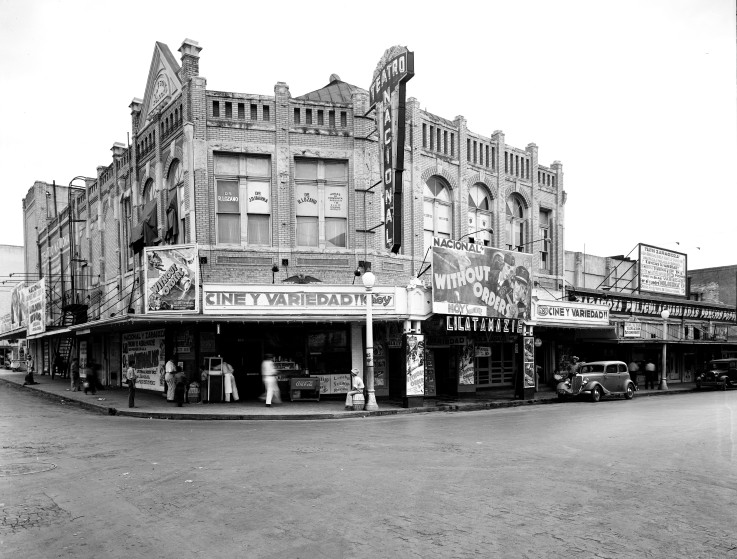Roma is the first-ever Spanish-language movie to win three Oscars, including Best Director for film director Alfonso Cuaron of Mexico City. The movie is mainly in Spanish, with the occasional use of Mixtec, an indigenous language still spoken in Oaxaca. This was the first feature-length movie in Spanish produced by an American film company. Previous highly popular Mexican movies had been made by Mexican film companies and producers.
The success of Roma reminds me of the Epoca de Oro (Golden Era) of Mexican film in the 1940s and 1950s. Mexican movies during this era were the gold standard for all of Latin America and Spain. Hollywood at the time had little interest in Mexican drama or Spanish-language films. One of the exceptions was Viva Zapata in which Anthony Quinn won an Academy Award for Best Supporting Actor. The Mexican movies were also successful in part because of the Spanish-language movie theaters like those in San Antonio which numbered at least a half dozen.
At the turn of the 20th century (1900), San Antonio had the largest Mexican population in the United States. In the Westside, where the majority of Mexicano-Americanos lived, Spanish-language newspapers, films, and radio were preferred over Hollywood produced movies.
Indeed, the residents of San Antonio maintained their Spanish-language skills and appreciation of Mexican cultural traditions because of the availability of films, music, and vaudeville from south of the border. This is the story of how the rise of Mexican teatros contributed to the bi-cultural community of San Antonio.
The story of Spanish-language teatros in San Antonio begins with the opening of Teatro Zaragoza on Commerce Street. I discovered in the Lucchese Boot Company website a reference to Salvatore Lucchese buying the Teatro Zaragoza in 1912, which would have made it the earliest Spanish-language theater in the city.
Next came the Teatro Nacional which opened in 1917 two doors east of the Zaragoza. Located on the corner of Santa Rosa and Commerce, the Nacional had a seating capacity of 1,000. The popularity of the Nacional was based on its ability to consistently book some of the best known Mexican bands and singers, vaudeville acts, and Mexican films.
The Progreso theater on Guadalupe Street, just a mile west of the Nacional, opened in the late 1920s just as the film industry converted from silent to “talking” movies. Former Texas State Senator Joe Bernal grew up a block from the barrio theater district and remembers selling candy to customers entering the Progreso theater in the mid-1930s.
Bernal loved watching movies at the Progreso and would stand near the entrance on Tuesdays and Thursdays when “dos por uno” (two for one) promotions were in effect. He got in free by convincing someone attending the movie alone to include him. On the weekends the Progreso offered popular Hollywood movies such as Tarzan and Flash Gordon. Bernal called the corner of Brazos and Guadalupe the “center of my universe.”
In 1941, a construction crew had already demolished Juan Vidaurri’s tire shop on the corner of Guadalupe and Brazos streets and had started building the Guadalupe Theater. The famed theatre opened its doors in 1942, just as America was sending its sons and daughters to fight in World War II.
The theater took the name Guadalupe to compliment the well known Guadalupe Catholic Church located one block north on El Paso Street. Centrally located, the Guadalupe Theater stood at the hub of a newly created commercial zone west of downtown, and its opening prompted the establishment of several nearby grocery stores, bakeries, and restaurants.
A block away from the Nacional, on Houston Street, the Alameda opened in 1949. Cinema Treasures noted that the Alameda Theater has a special place in American theater history as “the largest movie palace ever dedicated to Spanish language films & the performing arts.” According to the San Antonio Express-News, Gaetano “Tano” Lucchese developed the Alameda in the late 1940s. It is likely he was related to the Lucchese boot-making family in San Antonio, although he is not listed on the website which covers the company’s business from 1883 to the present.
During the war years, Hollywood made fewer movies because of the war rationing of cellulose. The few American movies produced were war movies designed to boost American patriotism. The Mexican filmmakers, seeing a void in films dealing with romance, drama and comedy began offering movies in those genres.
Theater patrons from the Westside actually had a choice of two excellent movie houses on Guadalupe and Brazos streets. However, the Guadalupe Theater featured only Spanish language movies, while the Progreso Theater offered English language movies on the weekends.
There had never been a better time to open a Spanish language theater than in the 1940s. For the Spanish speaking world, Mexican films featuring great singers, beautiful actresses, and entertaining comedians, more than filled the movie void. Westsiders flocked to see Pedro Infante, Jorge Negrete, Maria Felix, and Dolores de Rio, but for many movie fans, young and old, the films by Cantiflas and Tin Tan delighted the most.
In the age before television, everyone went to the movies. San Antonio had opened numerous theaters in the 1930s in the central area of downtown. While the trio of downtown Spanish-language theaters—Alameda, Nacional, and Zaragoza, all located near the old Market Square— offered movies in Spanish, going to the center of town with a family on the city bus was not feasible for many in that era. The early success of both of the Progreso and Guadalupe Theaters demonstrated that Westsiders appreciated neighborhood entertainment venues.
By the late 1950s, the golden era of barrio film entertainment was coming to an end as television replaced movies. For Latino families in the Westside, television was certainly cheaper and more convenient. Moreover, by that time the Mexican film industry had lost many of its stars and with this misfortune Mexican movies lacked their luster and appeal. Nonetheless, these historic theaters in San Antonio played an important part in the cultural life of the city. We should support the historical preservation of these Spanish-language theaters and there are efforts currently underway.
Preserving Mexican Culture in San Antonio: Los Teatros












